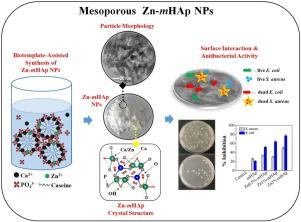Colloids and Surfaces B: Biointerfaces ( IF 5.4 ) Pub Date : 2020-11-16 , DOI: 10.1016/j.colsurfb.2020.111471 Cleibson Oliveira de Lima 1 , André L Menezes de Oliveira 1 , Laís Chantelle 1 , Edson C Silva Filho 2 , Maguy Jaber 3 , Maria Gardênia Fonseca 1

|
Recently, zinc-based materials have gained immense attention as antimicrobial agents. In this study, zinc-doped mesoporous hydroxyapatites (HAps) with various Zn contents were prepared by co-precipitation using a phosphoprotein as the porous template. The use of the phosphoprotein as the porous template resulted in the formation of zinc-doped mesoporous HAps (mHAps) with large pores and specific surface area (182 m2 g-1), as indicated by the nitrogen adsorption/desorption measurements. The formation of the zinc-doped HAps was confirmed by various analytical techniques such as X-ray diffraction, Fourier transform infrared spectroscopy, transmission electron microscopy, and X-ray photoelectron spectroscopy. The biomaterials prepared in this study were used as antimicrobial agents against gram-positive (Staphylococcus aureus) and gram-negative (Escherichia coli) bacteria. The Zn2%-mHAp sample showed the maximum bacterial inhibitory concentrations of 50 ± 5% and 77 ± 5% for the gram-positive and gram-negative bacteria, respectively. The antibacterial activity of the mHAp samples depended strongly on their Zn2+ content. Thus, the use of a biotemplate and Zn2+ ions is an efficient approach for the formation of novel HAp-based biomaterials with promising antibacterial properties. This synthesis approach will pave a new pathway for the functionalization of other materials for different biomedical applications.
中文翻译:

锌掺杂介孔羟基磷灰石及其抗菌性能
近来,锌基材料作为抗菌剂受到了广泛的关注。在这项研究中,使用磷蛋白作为多孔模板通过共沉淀制备了具有不同Zn含量的掺锌中孔羟基磷灰石(HAps)。使用磷蛋白作为多孔模板可导致形成具有大孔和比表面积(182 m 2 g -1)的锌掺杂介孔HAps(mHAps)。),如氮吸附/解吸测量所示。通过各种分析技术,例如X射线衍射,傅立叶变换红外光谱,透射电子显微镜和X射线光电子光谱,证实了掺杂锌的HAps的形成。在这项研究中制备的生物材料被用作革兰氏阳性(金黄色葡萄球菌)和革兰氏阴性(大肠杆菌)的抗菌剂。Zn2%-mHAp样品对革兰氏阳性和革兰氏阴性细菌的最大抑菌浓度分别为50±5%和77±5%。mHAp样品的抗菌活性在很大程度上取决于其Zn 2+含量。因此,使用生物模板和Zn 2+离子是形成具有前景的抗菌特性的新型基于HAp的生物材料的有效方法。这种合成方法将为其他材料用于不同生物医学应用的功能化铺平新途径。











































 京公网安备 11010802027423号
京公网安备 11010802027423号